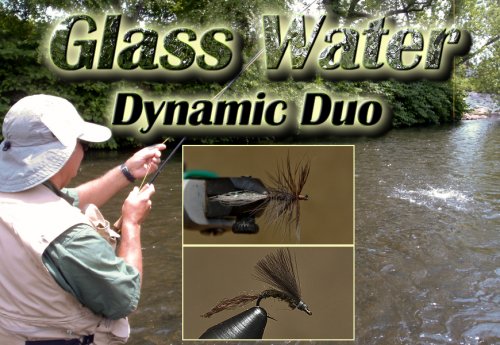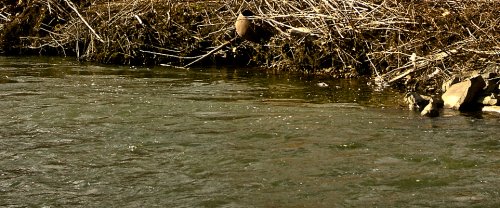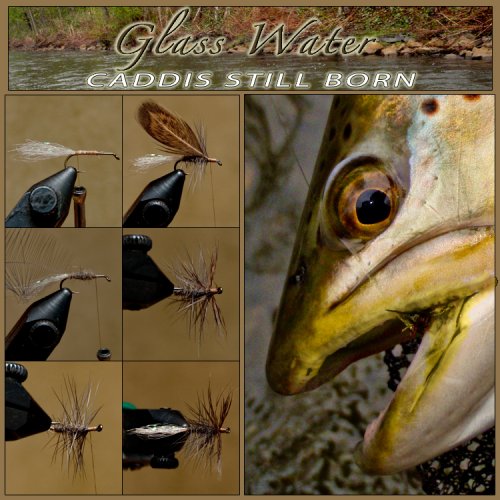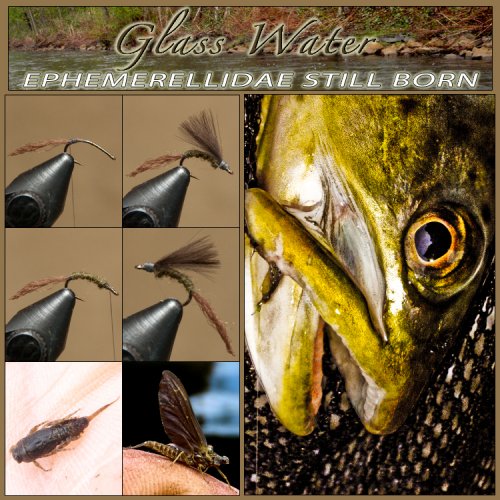Winter tying sessions for me always start with reflections of various days of my early fly casting formation, spent in the Lackawanna River, with a fly rod and flies, where the fish have bested my every attempt to engage them in battle...
Recently, given the extreme cold temperatures of this particularly cold winter, I have found myself catching up at the fly tying vice. It's one of the few "healthy" refuges I may seek to take the edge off the fact I can't effectively be in the water pursuing my finned quarry. For me, winter fly tying is not just a list of patterns that I need to have in my various fly boxes so I'm ready for the season. Winter tying sessions for me always start with reflections of various days of my early fly casting formation, spent in the Lackawanna River, with a fly rod and flies, where the fish have bested my every attempt to engage them in battle. These reflections often highlight a situation where the fish took the upper hand and forced me to seek a creative solution to the fact I didn't have the fly they wanted. I wish to share with you one of many such situations, as well, the solution to the problem.
Background
I started upon my fly casting path at the ripe ole' age of 12 years old. The first fly rod I received as a birthday present was an 8'6", 8wt. Ugly Stick fly rod, complete with a simple reel with no backing, and a double tapered 7wt. floating fly line. I come from humble means, and while my parents couldn't afford to get me what I wanted they always saw to it that I had what I needed. In hindsight, I wouldn't be nearly as effective an angler today had I not taught myself the art with such an ungainly outfit. Also, when I received this fly outfit I had no knowledge of what "the best one" was. So as blissful as ignorance was, to me, that fly outfit was "the best".
I grew up less than 1 mile from the Lackawanna River where it flows through Scranton PA. Back then, this river was a relatively undiscovered trophy fishery, and was seen by the local population as an open sewer. I started studying stream entomology in 4th grade and when I found mayflies, stoneflies, and caddis flies abundant in these waters, I knew very well that this river had reclaimed itself.
Starting in 1989 I would leave my house around sunrise and cover anywhere between 10 to 15 miles of river on foot and be back home after sunset. Keep in mind that this river flows through a population center so much of my route was on roads and sidewalks. I would walk about 3 miles to my first haunt, fish upstream a few hundred yards, get out walk a mile or two and repeat. By the time I was about 5 to 7 miles out I had a good knowledge of where fish were that I may have missed, or passed up, knowing I was going to turn around and fish back to my starting point.
I spent every day off from school or the weekend job, in the river.
Lessons of the Fish
As I spent more and more time in the river I started seeing behavioral patterns. For this article, the first and most important pattern I learned was that from late April through the end of the insect hatches in late fall, big trout do eat from the surface, but only in a select current formation. This select current formation is what I refer to as glass water. Glass water, which there is no deficit of in the Lackawanna River, is smooth, moderately flowing, unbroken water.
This glass water is rife with shoreline micro-currents and seams. The largest brown trout, that being 18" up to 20"+, will sit on a far seem throughout the day long tan caddis hatch, or sulphur may fly hatch on overcast misty days, and subtly, without wasting energy poke their beaks out of the water to lightly intercept hapless emergers and stillborns as they drift through the feed lane. This is a truth I've seen played out time and time again on other trout waters as well.
For the most part I enjoyed great success in the late 80's using the standard elk hair caddis, with and without palmered hackle, and comparaduns when the trout were keyed in on mayflies. On one particular day however I was met by a trout that not only bested my every attempt with my standard fly arsenal, but also drove me to the greatest depths of frustration. At the time I felt cursed, however, looking back now I see it as my greatest blessing.
It was an early afternoon in mid-May. The tan caddis started emerging in moderate but steady numbers around 10am. I was on the upstream leg of my typical angling foray. On the far bank were 2 or 3 micro-currents that flowed under an overhanging rhododendron branch. It only took me a year or two to develop the discipline and patience to scrutinize a drift for no less than a half hour to find the positions of feeding trout. Back then the trout would be lined up 3 to 5 deep, spaced apart by 10 to 15 yards, holding on their own little slice of current.
On this particular day there was a good fish holding just upriver of the overhang. Every 15 to 20 seconds or so it would create the softest of surface disturbance as it gently intercepted a caddis. Now, between my casting position and the feed lane was a big boulder that broke the current and caused a backflow of water such that casting directly across stream was futile. The fly after the cast would land in the seem but be ripped out of it when the fly line caught the backflow. This particular situation forced me to stealthily take an upstream position as close to the fish as possible, once in position remain motionless for about 5 minutes, and drop 1 ½ times the amount of line necessary above the fish, to reach the lie, about 10 feet in front of the position. This required aerializing much of the line and checking the rod instantly after the line turned over. Accuracy was a nightmare with that soft ugly stick. The excess line was necessary because if the fish didn't take on the cast I had to let the fly drift past it and swing the fly out and away, well below the fish's lie. Given the boulder backflow, and the overhang there was no other foreseeable alternative to getting a drift over my seemingly spiteful, finned nemesis.
This same situation occurred a few days earlier and it only took about 10 casts with an un-hackled elk hair caddis, to hook and release a solid 18" brown. Well on this day the fish in that lie refused perfect dead drifts, cast after cast, with the same caddis. I even tried skating it out which sometimes triggered them. That too failed. I knew it was feeding on caddis, because there were no mayflies anywhere. Growing ever more angered and having exhausted all other options, I said, "bleep this!!!" I reeled in the line, secured the fly, and proceeded to walk right into the fish's lie. I watched as he turned into the current and eased back, down river, until he disappeared into the shadow of the undercut bank. For about 2 hours I stood there and watched emerging caddis after emerging caddis. What I witnessed, forever changed how I look through "the trout's eyes".
Here's what I saw. The caddis appeared to be on a conveyor belt. Their exoskeletons were firmly locked into the surface tension of the water that created a dimpling effect in the surface tension. As they were coming out of their pupal exoskeletons, they glimmered brightly and the slightest of rings were emitted around them as they struggled to free themselves of their shuck. Once their wings were full they flitted once or twice and took to the air leaving their newly shed exoskeleton on the water's surface. Keep in mind that the whole transition happened over the course of a good distance. So I pieced together the glimpses of this process I witnessed. There was also a great deal of caddis drifting by that never made it. Their wings spread butterfly like locked in the surface tension of the water, while their hapless adult body became stuck due to the fact that they couldn't break the bonds of their partially shed exoskeleton. Having witnessed this event and seeing what are oft referred to as "still born" or "stuck in the shuck" emergers endlessly drifting by, forever changed my perspective and approach to surface feeding trout in the "glass water".
Over the course of the few hours I spent mesmerized by this phenomena my mind was racing, doing an inventory of tying materials I had at my disposal that would adequately replicate the still born caddis. Keep in mind that this event transpired in 1990. I was an old 15 years of age at the time. Z-lon trailing shucks were just becoming mainstream, well, insofar as my knowledge base at the time was concerned, but it was clearly evident that the spun polypropylene yarn I had at home was going to get used.
As my eyes watched the conveyor belt of emergers drifting by, I was visualizing a tied version that would depress the film and fully accentuate all the parts of the bug that caused the film to depress in such a fashion. The fly I created in my mind, standing in the river that day had a trailing z-lon shuck. Palmered hackle over a dubbed hares mask fur, clipped flush on the bottom, complete with three wraps of soft hackle that I took from the underside of a pheasant. Today I use Hungarian partridge or India hen hackle. The hackle served not only to represent the legs, but also the light translucent under wing, and the soft hackle served to represent the opaque heavier outer wing. Once my mental image was fully whipped off in my mind's tying vice I bee lined it home at a forced march pace that was just short of a full on sprint.
Here's the first pattern I developed to meet a very real need in my river.
Note: The trailing shuck has no more than 3-4 strands of pearl crystal flash embedded in it. Crystal flash didn't exist when I was younger however I find it makes seeing the pattern a bit easier. The poly yarn is then folded back on itself and rolled between the fingers before being tied in. It's better to be too sparse than too full with the trailing shuck. I do not burn the poly yarn because I have found the burnt end to pull the fly underneath the water. This pattern should never be dressed with any liquid floatant as it will mat down the soft hackle. To dry the pattern or remove fish slime from it simply apply a desilicate akin to frog's fanny powder or similar product.
While I was at the vice I also followed suit with a mayfly still born that represented the various colors and size of the "clinger type" mayfly, that being the ephemerellidae. In my waters they manifest as the Blue winged olive, the Hendrickson, and the sulphur. It's the same pattern, just tied to different sizes and colors to achieve the look of the "fly du jour".
Outside the "window"
Before leaving you to your thoughts and to your tying bench, I'd like to leave you with one other observation I have made that goes hand and hand with the glass water. That being, "what the fish see" in, on, and on top of the water. Light, by virtue of the way it is bent creates what is referred to as a "window" on the surface. It's a cone of view where by what is outside of the water, is able to be seen. Outside this circular window, the bottom of the river is reflected. As the distance of the fish to the water's surface gets closer to the surface this window decreases in diameter. What ever is on the surface, outside of this window, appears to be just an undefined depression in the surface tension of the water. Based on years of observation, the trout that take up feeding positions in the glass water often hold inches below the surface. Given their holding position, and close proximity to the surface, there is no way they may be able to discern what the insect looks like on the outside of the water. Essentially, they are feeding on nothing more than light refracting depressions in the water's surface. Often times with caddis and mayflies, when they are hatching from the film, the only thing that is below the surface is their empty, air filled, glistening, exoskeleton.
Both patterns shown above, and the caddis in particular are designed to create a relatively heavy depression in the film with the poly-pro shuck present beneath the surface to give the impression of an insect that is not able to flee the surface before the trout may eat it. It's imperative to note that fish are not like us and do not exercise. They will not waste time chasing food that does not merit a greater intake of calories than are spent taking calories in. The biggest surface caught browns I have ever tangled with have all come to flies that are designed to look immobilized in the surface tension of the "glass water".
















